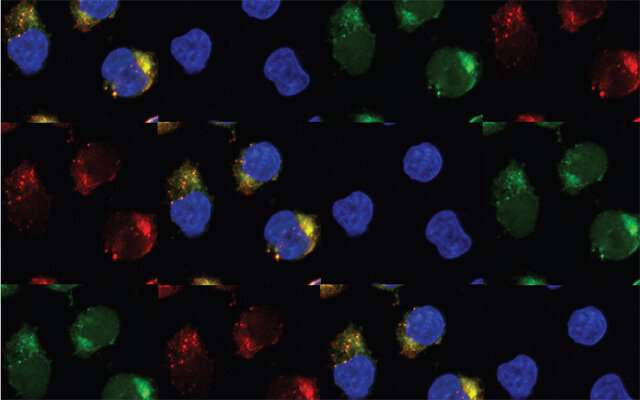Two antiviral enzymes transform pre-leukemia stem cells into leukemia

Since stem cells can continually self-regenerate, making more stem cells, and differentiate into many different specialized cell types, they play an important role in our development and health. But there can also be a dark side—stem cells can sometimes become cancer stem cells, proliferating out of control and leading to blood cancers, such as leukemia and multiple myeloma. The self-renewing nature of cancer stem cells makes them particularly hard to eradicate, and they're often the reason a blood cancer reoccurs.
Researchers at UC San Diego Health and University of California San Diego School of Medicine are working to understand what pushes pre-cancer stem cells to transform into cancer stem cells and are developing ways to stop that switch.
Their latest study, published January 26, 2021 in Cell Reports, is the first to show that, in response to inflammation, two enzymes called APOBEC3C and ADAR1 work together to fuel the transition from pre-cancer stem cells to cancer stem cells in leukemia. Both APOBEC3C and ADAR1 are activated by inflammatory molecules, especially during the body's immune response to viruses.
The researchers also found they can prevent the formation of leukemia stem cells in the laboratory by inhibiting ADAR1 with fedratinib or ruxolitinib, two existing medications for myelofibrosis, a rare bone marrow cancer.
"APOBEC3C and ADAR1 are like the Bonnie and Clyde of pre-cancer stem cells—they drive the cells into malignancy," said co-senior author Catriona Jamieson, MD, Ph.D., Koman Family Presidential Endowed Chair in Cancer Research, deputy director of Moores Cancer Center, director of the Sanford Stem Cell Clinical Center and director of the CIRM Alpha Stem Cell Clinic at UC San Diego Health.
Jamieson's team has long studied ADAR1, an enzyme that edits a cell's genetic material to control which genes are turned on or off at which times, and its role in leukemia stem cells. They also previously found that high ADAR1 levels correlate with reduced survival rates for patients with multiple myeloma.
In their new study, the researchers collected blood stem cells and saliva samples donated by 54 patients with leukemia and 24 healthy control participants. They compared the whole genome sequences of pre-leukemia stem cells and leukemia stem cells collected from the patients. They were surprised to discover an uptick in levels of both the enzyme APOBEC3C and ADAR1 during the progression to leukemia stem cell. APOBEC3C typically helps cells maintain genomic stability.
The team found that, in response to inflammation, APOBEC3C promotes the proliferation of human pre-leukemia stem cells. That sets the stage for ADAR1, which becomes overzealous in its editing, skewing gene expression in a way that supports leukemia stem cells. When the researchers inhibited ADAR1 activation or silenced the gene in patient cells in the laboratory, they were able to prevent the formation of leukemia stem cells.
APOBEC3C, ADAR1 and their roles in cancer stem cells are now the focus of Jamieson's NASA-funded project to develop the first dedicated stem cell research laboratory within the International Space Station (ISS).
That's because the NASA Twins Study—a comprehensive biological comparison of identical twins Scott Kelly, who spent six months aboard the ISS, and Mark Kelly, who stayed on Earth—revealed an increase in inflammatory growth factors, immune dysregulation and pre-cancer mutations in Scott's blood upon his return. These molecular changes, the perfect conditions to activate APOBEC3C and ADAR1, persisted for almost a year.
"Under the auspices of our NASA task order, we are now developing APOBEC3C and ADAR1 inhibitors as a risk mitigation strategy for astronauts, so we can hopefully predict and prevent pre-cancer stem cell generation in low-Earth orbit and on deep space missions," Jamieson said.
The team is also interested in further exploring the link between viral infections and cancer. According to Jamieson, infection with viruses can trigger a flood of cytokines, molecules that help stimulate the body's immune forces. As part of that response, ADAR1 is activated to help immune cells proliferate.
"We need APOBEC3C and ADAR to help us fight off viruses," she said. "So now we're wondering—do these enzymes play a role in the immune response to COVID-19? And could there be a downside to that as well? Can the immune response to a viral infection later raise a person's risk of pre-cancer stem cell development and ultimately cancer stem cell generation, and can we intervene to prevent that?"
More information: Qingfei Jiang et al. Inflammation-driven deaminase deregulation fuels human pre-leukemia stem cell evolution, Cell Reports (2021). DOI: 10.1016/j.celrep.2020.108670




















